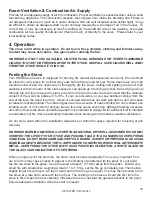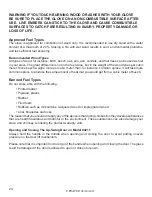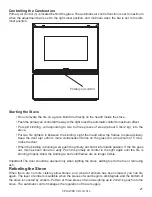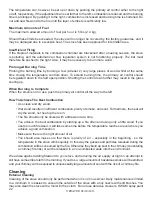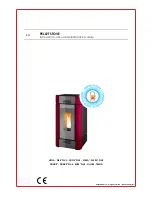
19
UPDATED 09/20/2013
Room Ventilation & Combustion Air Supply
Provide for an adequate supply of air for combustion. Proper ventilation is essential when using a solid
fuel-burning appliance. The combustion process uses oxygen from inside the dwelling and if there is
not adequate make-up air (such as in newer homes which are well insulated and weather tight), it may
be diffi cult to obtain an adequate draft in your chimney (caused by a shortage of air in the house). To
correct this, it may be necessary to crack a window on the windward side of the dwelling, or provide
combustion air to a nearby fl oor/wall vent (fresh air duct), or directly to the stove. Please refer to your
local building codes.
4. Operation
The stove is hot while in operation. Do not touch. Keep children, clothing and furniture away.
Contact may cause skin burns. Use gloves when stoking the fi re.
WARNING! DO NOT USE GASOLINE, LIGHTER FLUID, KEROSENE OR OTHER FLAMMABLE
LIQUIDS TO START OR FRESHEN A FIRE IN THE STOVE. KEEP ALL SUCH LIQUIDS WELL AWAY
FROM THE STOVE WHILE IT IS IN USE.
Fueling the Stove
Your HWAM wood stove is designed for burning dry natural well-seasoned wood only. Wood should
be stored in a dry place for at least two years before being used for fuel. Some trees have very high
moisture content and it is necessary to thoroughly dry the wood. Cutting and splitting the wood, then
stacking it with both ends of the stick exposed, can speed up the drying process. More drying occurs
through the end than through the sides even when the wood is split. We recommend that the moisture
content of the wood be between 15-18%. If your wood sizzles, or you see bubbles coming from the
end of the logs, the wood is not dry. Green or uncured wood does not work well as fuel, and can cause
increased creosote buildup. The value of green wood as a source of heat is limited. Do not overload, use
kindling wood, or mill ends for primary fuel as this may cause over-fi ring. Although feeding excessive
amounts of fuel to the stove should be avoided, it is important to supply it with suffi cient fuel to maintain
a moderately hot fi re (this is particularly important since burning wood produces volatile substances).
Do not store wood within the installation clearances or within the space required for refueling or ash
removal.
WARNING! BURNING MATERIALS OTHER THAN NATURAL DRY WELL-SEASONED WOOD MAY
SHORTEN THE LIFE OF YOUR STOVE AND POSSIBLY LEAD TO A DANGEROUS OVER-FIRING
CONDITION. DO NOT BURN GARBAGE, PARTICLE BOARD, SCRAPS OR PRESSED LOGS USING
BONDING AGENTS BECAUSE THEY CAN PRODUCE CONDITIONS, WHICH WILL DETERIORATE
METAL. OVER FIRING THE STOVE MAY CAUSE PAINT DISCOLORATION. A WHITE GLAZE ON
THE GLASS IS AN INDICATION OF OVER FIRING.
When you light up for the fi rst time, the stove must be heated gradually. This is very important. Fail-
ure to do this may cause cracks to appear in the Skamol or problems with the paint. Do not build
the fi re too close to the glass. Keep the wood at least 2” (51 mm) away from the glass. Build a very
small fi re with small sticks weighing a total of 1 to 1.5 lbs. Let the fi re go completely out. Then build a
slightly larger fi re with up to 2.5 lbs of wood and let the fi re go out again. You may then proceed to fi re
the stove at a rate not to exceed 5 lbs per hour. The coating on the stove will cure the fi rst time the
stove is fi red. Open the door carefully; otherwise there is a risk that the gaskets will stick to the paint.
Ensure adequate ventilation while the odor is present.
Summary of Contents for 04201
Page 33: ...33 UPDATED 09 20 2013 ...















